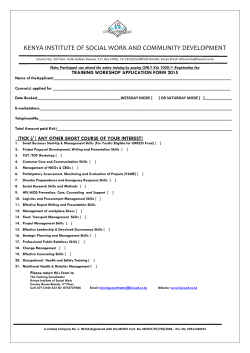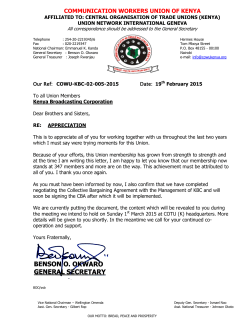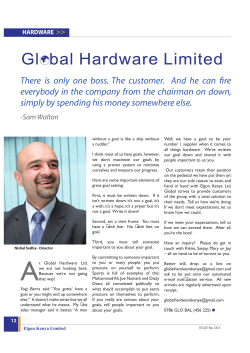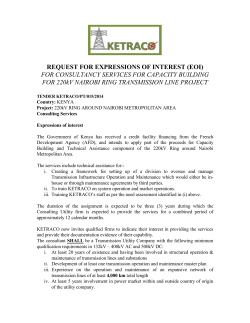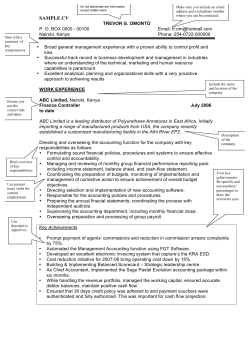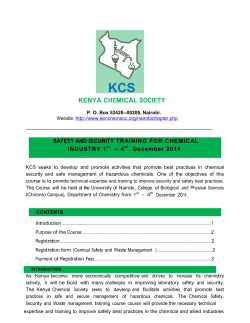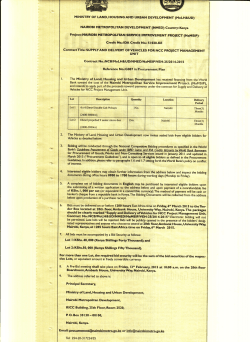
Federal Register/Vol. 80, No. 37/Wednesday, February 25
Federal Register / Vol. 80, No. 37 / Wednesday, February 25, 2015 / Notices disclosed under the APO in accordance with 19 CFR 351.305(a)(3), which continues to govern business proprietary information in this segment of the proceeding. Timely written notification of the return or destruction of APO materials or conversion to judicial protective order is hereby requested. Failure to comply with the regulations and the terms of an APO is a sanctionable violation. Notification to Importers This notice also serves as a final reminder to importers of their responsibility under 19 CFR 351.402(f)(2) to file a certificate regarding the reimbursement of antidumping duties prior to liquidation of the relevant entries during this review period. Failure to comply with this requirement could result in the Secretary’s presumption that reimbursement of antidumping duties occurred and the subsequent assessment of double antidumping duties. These final results of administrative review and notice are published in accordance with sections 751(a)(1) and 777(i)(1) of the Act and 19 CFR 351.213(h). Dated: February 18, 2015. Paul Piquado, Assistant Secretary for Enforcement and Compliance. [FR Doc. 2015–03897 Filed 2–24–15; 8:45 am] BILLING CODE 3510–DS–P DEPARTMENT OF COMMERCE International Trade Administration [Application No. 99–8A005] Export Trade Certificate of Review Notice of Application to Amend the Export Trade Certificate of Review Issued to California Almond Export Association, LLC (‘‘CAEA’’), Application No. (99–8A005). ACTION: The Office of Trade and Economic Analysis (‘‘OTEA’’) of the International Trade Administration, Department of Commerce, has received an application to amend an Export Trade Certificate of Review (‘‘Certificate’’). This notice summarizes the proposed amendment and requests comments relevant to whether the amended Certificate should be issued. FOR FURTHER INFORMATION CONTACT: Joseph Flynn, Director, Office of Trade and Economic Analysis, International Trade Administration, (202) 482–5131 (this is not a toll-free number) or email at etca@trade.gov. asabaliauskas on DSK5VPTVN1PROD with NOTICES SUMMARY: VerDate Sep<11>2014 18:05 Feb 24, 2015 Jkt 235001 Title III of the Export Trading Company Act of 1982 (15 U.S.C. Sections 4001–21) (‘‘the Act’’) authorizes the Secretary of Commerce to issue Export Trade Certificates of Review. An Export Trade Certificate of Review protects the holder and the members identified in the Certificate from State and Federal government antitrust actions and from private treble damage antitrust actions for the export conduct specified in the Certificate and carried out in compliance with its terms and conditions. The regulations implementing Title III are found at 15 CFR part 325 (2014). Section 302(b)(1) of the Export Trade Company Act of 1982 and 15 CFR 325.6(a) require the Secretary to publish a notice in the Federal Register identifying the applicant and summarizing its application. Under 15 CFR 325.6(a), interested parties may, within twenty days after the date of this notice, submit written comments to the Secretary on the application. SUPPLEMENTARY INFORMATION: Request for Public Comments Interested parties may submit written comments relevant to the determination whether an amended Certificate should be issued. If the comments include any privileged or confidential business information, it must be clearly marked and a nonconfidential version of the comments (identified as such) should be included. Any comments not marked as privileged or confidential business information will be deemed to be nonconfidential. An original and five (5) copies, plus two (2) copies of the nonconfidential version, should be submitted no later than 20 days after the date of this notice to: Export Trading Company Affairs, International Trade Administration, U.S. Department of Commerce, Room 21028, Washington, DC 20230. Information submitted by any person is exempt from disclosure under the Freedom of Information Act (5 U.S.C. 552). However, nonconfidential versions of the comments will be made available to the applicant if necessary for determining whether or not to issue the amended Certificate. Comments should refer to this application as ‘‘Export Trade Certificate of Review, application number 99–8A005.’’ Summary of the Application Applicant: California Almond Export Association, LLC (‘‘CAEA’’), 4800 Sisk Road Modesto, CA 95356. Contact: Bill Morecraft, Chairman, Telephone: (916) 446–8537. Application No.: 99–8A005. PO 00000 Frm 00010 Fmt 4703 Sfmt 4703 10053 Date Deemed Submitted: February 6, 2014. Proposed Amendment: CAEA seeks to amend its Certificate to delete the following company as a Member of CAEA’s Certificate: Minturn Nut Company, Inc., Le Grand, CA. CAEA’s proposed amendment of its Export Trade Certificate of Review would result in the following companies as Members under the Certificate: Almonds California Pride, Inc., Caruthers, CA, Baldwin-Minkler Farms, Orland, CA, Blue Diamond Growers, Sacramento, CA, Campos Brothers, Caruthers, CA, Chico Nut Company, Chico, CA, Del Rio Nut Company, Inc., Livingston, CA, Fair Trade Corner, Inc., Chico, CA, Fisher Nut Company, Modesto, CA, Hilltop Ranch, Inc., Ballico, CA, Hughson Nut, Inc., Hughson, CA, Mariani Nut Company, Winters, CA, Nutco, LLC d.b.a. Spycher Brothers, Turlock, CA, Paramount Farms, Inc., Los Angeles, CA, P–R Farms, Inc., Clovis, CA, Roche Brothers International Family Nut Co., Escalon, CA, South Valley Almond Company, LLC, Wasco, CA, Sunny Gem, LLC, Wasco, CA, Western Nut Company, Chico, CA. Dated: February 19, 2015. Joseph Flynn, Director, Office of Trade and Economic Analysis, International Trade Administration. [FR Doc. 2015–03784 Filed 2–24–15; 8:45 am] BILLING CODE 3510–DR–P DEPARTMENT OF COMMERCE International Trade Administration Trade Mission to South Africa, Kenya and Mozambique International Trade Administration, Department of Commerce. ACTION: Replacement of Trade Mission Statement. AGENCY: The United States Department of Commerce, International Trade Administration is replacing a notice published June 14, 2014, at 79 FR 36290, for the Trade Mission to South Africa and Mozambique, With an Optional Stop in Kenya; February 23– 27, 2015. SUPPLEMENTARY INFORMATION: Replacement of Trade Mission Statement. SUMMARY: Background The United States Department of Commerce, International Trade Administration is replacing its Trade Mission to South Africa and E:\FR\FM\25FEN1.SGM 25FEN1 10054 Federal Register / Vol. 80, No. 37 / Wednesday, February 25, 2015 / Notices Mozambique, With an Optional Stop in Kenya; February 23–27, 2015 with a new trade mission as notified herein. Replacement. Trade Mission to Mozambique, Kenya and South Africa June 18–26, 2015 asabaliauskas on DSK5VPTVN1PROD with NOTICES Mission Description The U. S. Department of Commerce, International Trade Administration, is organizing a Trade Mission to Mozambique, Kenya and South Africa, June 18–26, 2015, which will be led by a senior executive of the U.S. Department of Transportation. The mission is designed to help U.S. firms find business partners and sell equipment and services. Target sectors holding high potential for U.S exporters include: Transportation Infrastructure and Equipment, such as: road, bridge and dam construction and reconstruction; automatic fare collection systems, new and refurbished railroad locomotives, new bulk car and other dedicated rolling freight fleets, smart signaling and rail operation automation, rolling stock depot design, strategic route design and network planning, port mobile, weighbridges and quayside systems and upgrading of existing port equipment and oil and gas development infrastructure. Energy Equipment and Services, such as: power generation (including renewable energy); transmission and distribution (including smart grid), energy efficiency, oil and gas exploration and production and project development. Agricultural Equipment, such as: crop production equipment and machinery, irrigation equipment and technology, crop storage and handling, precision farming technologies and fertilizers. Although focused on the sectors above, the mission also will consider participation from companies in other appropriate sectors as space permits. This trade mission will include oneon-one business appointments with prescreened potential buyers, agents, distributors and joint venture partners; meetings with national and regional government officials, chambers of commerce, and business groups; and networking receptions. The mission will help participating firms and trade associations gain market insights, make industry contacts, solidify business strategies, and advance specific projects, with the goal of increasing U.S. exports to Mozambique, Kenya and South Africa. VerDate Sep<11>2014 18:05 Feb 24, 2015 Jkt 235001 Commercial Setting Mozambique, with a population of 23 million, grew its economy from 1994 to 2009 at an average rate of eight percent per year—one of the fastest rates of growth of any sub-Saharan African economy over this period. In 2013, GDP reached $15 billion. While the country was devastated after the civil war ended in 1992, it has since benefited from macroeconomic reforms and large foreign investment projects. Though infrastructure remains weak and the population is still largely rural, the government is committed to building a strong commercial environment. The United States has traditionally been a relatively minor trading partner, but U.S. investment in the energy sector, particularly off-shore natural gas, is expected to grow tremendously in the next several years. External competition, local labor quotas, periodic flooding, and an oftencontentious political situation present some challenges to doing business in Mozambique. Kenya, with a population of 43 million, is the dominant economy in the East African Community. Given its position as the economic, commercial, and logistical hub of East Africa, more U.S. companies are investing in Kenya and setting up local and regional operations there. Kenya’s first election under a new constitution with a devolved government structure was held in April 2013, and should position it for further growth. Investor confidence is high, as demonstrated by Kenya’s record-breaking $2 billion debut sovereign bond offering in 2014. Kenya also boasts a large number of well-educated English-speaking and multi-lingual professionals, and a strong entrepreneurial tradition. Doing business in Kenya includes a number of challenges, such as crime, unemployment, limited infrastructure, and corruption. South Africa, a country of 52 million people, has the most advanced, broadbased industrial economy in Africa, enjoys relative macroeconomic stability and boasts sound financial, legal and accounting institutions; not to mention an English-speaking workforce. It remains the primary choice for U.S. companies wishing to develop the promising markets of sub-Saharan Africa, although it suffers from large disparities in income distribution and over 25 percent unemployment. In 2014 South Africa’s GDP grew by less than two percent to $357 billion. Doing business in South Africa includes a number of challenges including corruption and power shortages, as well PO 00000 Frm 00011 Fmt 4703 Sfmt 4703 as a series of protectionist policies that has precipitated a series of downgrades by the major credit agencies. Best Prospects in Targeted Sectors Transportation Infrastructure and Equipment Mozambique Transport networks and infrastructure will be instrumental to developing Mozambique’s growth potential in the near and long term. The recently concluded $500 million Millennium Challenge Corporation compact funded extensive rehabilitation of key roads, a dam, and a water supply project in two northern provinces. The Government of Mozambique is investing heavily in expanding rail and port capacity to manage the rising production of mineral resources. A rail line to the deepest natural port on the East Coast of Africa should significantly lower coal transport costs, and two foreign companies have recently been contracted to begin work on a new rail line ending at Macuze port. As total coal exports are projected to reach 40 million tons per year by 2015 and long term estimates are in the range of 100 million tons per year, infrastructure around this sector remains a priority. In addition, rapid investment in infrastructure to support planned liquefied natural gas (LNG) projects in northern Mozambique, one of its least developed regions, could bring vast opportunities to U.S. firms. Kenya Kenya enjoys an extensive, but uneven, infrastructure that is still superior in many cases to that of its neighbors. Nairobi is the undisputed transportation hub of Eastern and Central Africa and the largest city between Cairo and Johannesburg. The Port of Mombasa is the most important deep-water port in the region, supplying the shipping needs of more than a dozen countries despite persistent deficiencies in equipment, inefficiency and corruption. As a result of these deficiencies, the Port of Mombasa has been earmarked for major expansion and re-habilitation. Kenya’s ‘‘Vision 2030’’ infrastructure development plans call for significant improvements to the provision of water, renewable energy, ICT, housing, roads, bridges, railways, seaports and airports over the next 20 years. The construction industry in Kenya is driven primarily by two key infrastructure sectors: Transportation and housing, given the large housing deficit that exists in Kenya. Construction and infrastructure development will also present new opportunities, especially with the E:\FR\FM\25FEN1.SGM 25FEN1 Federal Register / Vol. 80, No. 37 / Wednesday, February 25, 2015 / Notices asabaliauskas on DSK5VPTVN1PROD with NOTICES passage of the new public-private partnership (PPP) law which will make government procurements more transparent and less risky. South Africa South Africa’s Transnet, the largest State Owned Enterprise (SOE) within the Department of Public Enterprises (DPE) has announced and allocated funding for significant transportation infrastructure capital investments. In 2012, the government announced the allocation of funding for investments estimated at over $90 billion over 15 years. Though there have been complaints of slow implementation, leading some contractors to re-focus business elsewhere in the continent, in late 2013 and early 2014 commitments were made to procure passenger rolling stock, locomotives, signaling and track upgrades. Also, the development of the significant Durban phase 2 port extension (in the old Durban International Airport precinct) has been initiated. The Passenger Rail Agency of South Africa (Prasa) of the SA Department of Transport (SADOT) in March 2012 announced a 20-year rail improvement program estimated at more than $13.6 billion. Of this, $1.3 billion will be invested in signaling, new depots, modern stations and integrated ticketing, while $1.1 billion is being spent on new locomotives. SOE Transnet Freight Rail (TFR) and others are expanding logistics projects such as upgrading the Sishen-Saldanha Bay ore line, the Richard Bay coal line and other new coal line networks in the northwest. Transnet’s rail and port projects are reportedly set to cost around $30 billion over seven years and include augmenting the tractive and bulk car fleet, signaling, maintenance, advanced train management systems and network expansion/concession models. For the second large diesel locomotive program of 465 units, one U.S. and one Chinese manufacturer were selected as preferred bidders in February 2014. Transnet Port Terminals (TPT), the port operating SOE is set to invest $3.3 billion over the next seven years for the expansion and improvement of its bulk and container terminals. Significant capacity-creating projects included the expansion of the Durban Container Terminal’s (DCT’s) Pier 1 that would increase its capacity from 700,000 twenty-foot equivalent units (TEUs) to 820,000 TEUs by 2013 and 1.2 million TEUs by 2016/17. Other expansion projects include the Ngqura Container Terminal, Durban Ro-Ro and Maydon Wharf terminal, the iron-ore bulk VerDate Sep<11>2014 18:05 Feb 24, 2015 Jkt 235001 terminal at the Port of Saldanha and the ageing Richards Bay Terminal where $370 million is set aside for mobile and quayside equipment, as well as weighbridges. Energy Mozambique Mozambique is set to become one of the world’s largest new suppliers of natural gas. The country’s massive offshore discoveries have launched a scramble among exploration and production companies to develop these new-found resources. In early 2014, the Oil and Gas Journal raised Mozambique’s proven reserves to 100 trillion cubic feet (Tcf), making it the third-largest proved natural gas holder in Africa. Although much of the Mozambique’s offshore acreage still remains underexplored, one U.S. company already has announced recoverable finds totaling some 45–65 Tcf. The country’s rich resources could support up to ten LNG trains in one province alone, and a floating LNG facility is under consideration. Developers focusing on Mozambique’s LNG infrastructure expect to begin exporting as early as 2018. Additionally, although the United States exported only $25 million of oil and gas field equipment to Mozambique in 2013, this is up from $1 million only five years prior and comprises about 19 percent of the country’s relatively small total of $132 million for that year. More than 80 percent of U.S. exports to Mozambique are in pipe products, indicating the early stages of the industry. Mozambique is a net exporter of energy. But in order to support its growing economy the country requires significant investment to upgrade old infrastructure and conclude new generation projects. The majority of power produced in the country comes from the Cahora Bassa hydro-power scheme in central Mozambique, where the government plans a multi-million dollar ‘‘North Bank’’ expansion. It will add an additional 1,250 MW with transmission lines to South Africa, the South African Power Pool, Maputo, and Northern Mozambique. Planning for a second multi-billion dollar, 1,500-plus MW hydropower dam 35 miles downstream at Mphanda Nkuwa is well underway, and the operators are expected to finalize financing this year, with commercial operations due to start as early as 2017. The government of Mozambique recently approved new renewable feed-in tariffs as part of an ongoing strategy to promote private investment in renewable energy sources. PO 00000 Frm 00012 Fmt 4703 Sfmt 4703 10055 Kenya In response to strong economic growth and increasing demand for electricity, Kenya is focused on developing its power generation and transmission and distribution infrastructure. Today, Kenya is faced with brownouts, blackouts, and power surges that damage equipment and necessitate emergency power, driving up the cost of electricity. The supply deficit and costly short-term solutions impede economic growth, and reduce the competitiveness of Kenya’s private sector in the region. With only 25 percent of the population connected to the grid, the Kenyan government is currently implementing a plan to connect an additional 5,000MW to the grid to meet growing demand and help reduce electricity tariffs by 40 percent by 2017, with a goal of achieving universal access by 2030. In ITA’s Renewable Energy Top Markets for U.S.-Exports 2014–2015, Kenya was ranked 13th most promising export market for U.S. renewable energy companies, and first in the geothermal sector, which makes up about 22 percent of Kenya’s energy mix (about 583 MW). More than 40 wells per year currently are being drilled, with a target of developing over 5,000 MW, approximately half of its capacity, in the next two decades. Kenya has extensive plans to increase other renewables as well. The country is gradually diversifying its energy mix and is keen to wean off expensive thermal diesel power, whose supply is impacted by recurring droughts; and thermal power, which is sensitive to global fuel prices. Kenya is also an increasingly promising player in the booming East Africa oil and gas market. The multiple onshore discoveries announced since 2012, largely in Turkana County, have led exploration and production companies to sound optimistic notes about the country’s potential. The greatest enthusiasm surrounds offshore resources, where drillers hope to replicate Mozambique and Tanzania’s vast natural gas discoveries. To date, Kenya’s oil resources are estimated to be 600 million barrels, with at least one firm projecting that Kenya’s resource base could amount to as much as 10 billion barrels, though exploration is still in the early stages. While movement on key planned infrastructure projects, such as the $25 billion Lamu Port, South Sudan Ethiopia, Transport (LAPSSET) Corridor, has been slow, if all goes smoothly, a Uganda-Kenya pipeline could be completed by as early as 2019. E:\FR\FM\25FEN1.SGM 25FEN1 asabaliauskas on DSK5VPTVN1PROD with NOTICES 10056 Federal Register / Vol. 80, No. 37 / Wednesday, February 25, 2015 / Notices South Africa Electricity supply constraints are significant and are expected to remain a feature of South Africa’s social and economic landscape for several years to come. ESKOM, the government owned power utility, with a virtual monopoly on generation, transmission and distribution (responsible for around 95 percent of local generation) is experiencing budgetary and infrastructure challenges. As a result of these challenges, the government has put a renewed focus on the increased generation of power, increased energy efficiency and decreased consumption. ESKOM’s reserve of power has recently become so low that it has been forced to utilize its contractual rights with large industrial users to require them to reduce consumption at critical times, and it has implemented scheduled brownouts or ‘‘load-shedding’’ outages for all users. It has also been forced to use expensive diesel to power generators at peak load periods. Though there is current and planned infrastructure investment to ensure future supply, there have been significant delays in bringing these planned power generation facilities on line. ESKOM is currently investigating smart grid as an option to manage peak load demand. Renewable energy programs have also been introduced in order to facilitate clean renewable independent energy production. The government’s Renewable Energy Independent Power Producer Procurement program (REIPPP) has been relatively successful and marks the first time independent power producers have been allowed to sell power back to the grid. In ITA’s Renewable Energy Top Markets for U.S.-Exports 2014–2015, South Africa was ranked 12th; however, local content requirements, which have increased in recent months, may limit potential U.S. exports. Further capital expenditure is ongoing with the two large scale coal-fired plants under construction—Medupi Power Station (4,800 MW) and Kusile Power Station (4800 MW)—as well as a pumped storage project (1,332 MW) and a wind energy facility (1,00MW). With on-going power outages, the government of South Africa has also recently opened bids to independent power producers for the provision of 2,500 MW of baseload (coal) power. South Africa boasts the world’s eighth largest supply of technically recoverable shale gas resources, according to the U.S. Department of Energy’s Energy Information Administration. In 2012, the government lifted a moratorium on VerDate Sep<11>2014 18:05 Feb 24, 2015 Jkt 235001 exploring the country’s estimated 390 trillion cubic feet (tcf) of unconventional deposits. While licenses have yet to be issued, President Zuma announced in June 2014 that the government would proceed with shale gas development plans, indicating the government’s willingness to move forward with development in the sector. South Africa has announced plans to add 9,600 MW of nuclear power over the next twenty years and the government is in talks with multiple countries about resources to develop South Africa’s civil nuclear energy program. The country currently has two nuclear reactors that generate 5 percent of its electricity. Agricultural Equipment Mozambique Mozambique has vast needs and vast opportunities in the agriculture sector. Boasting a landmass about the size of Texas and Louisiana combined, a coastline longer than the eastern seaboard of the United States, and a geographic location well-positioned to export to burgeoning Asian markets, agriculture is still small-scale and subsistence. Growth in agriculture has lagged in relation to GDP growth, largely due to the lack of mechanization and irrigation. Opportunities for U.S. companies vary from cold storage, irrigation and food processing equipment. Mozambique recognizes agriculture as the key to poverty reduction and employment and is focused on policy reforms to attract more private sector investment. The Government of Mozambique is committed to promoting the use of technology, irrigation, and improved methods to raise yields. This commitment has resulted in plans by U.S. and other foreign agribusiness companies to establish commercial farms. Kenya Agriculture remains the backbone of Kenya’s economy. It accounts for about 24 percent of GDP directly and 75 percent of the labor force indirectly. Cash crop (tea, coffee, and horticulture), food crops (maize, wheat and rice), and livestock dominate the agricultural sector. Kenyan agriculture faces many challenges. It is predominately rainfall dependent and thus subject to wide production variances. It is undercapitalized, implying low technological absorption resulting in low productivity. Small-scale farmers contribute about 75 percent to the country’s total value of agricultural output and account for nearly 85 PO 00000 Frm 00013 Fmt 4703 Sfmt 4703 percent of total employment in the agricultural sector. These attributes, coupled with challenges arising from limited institutional capacity, poor infrastructure, and risks associated with liberalized markets, explain the relative stagnation of agricultural productivity and incomes. Kenya’s horticulture industry is a major export success in Africa. It is almost entirely dominated by the private sector and provides many opportunities for increased importation of fertilizers, pesticides and equipment. Similar opportunities lie in the floriculture industry in Kenya, which is the leading exporter of fresh cut flowers to the flower auction in Holland. Other important commodities include maize, tea, coffee, sugarcane and wheat, which will require additional use of fertilizers as production grows. The government has embarked on a mechanization program to increase use of more modern means of farming to increase output. In addition, the government has set aside 1.2 million acres of land for irrigation that for growing maize and wheat, and livestock farming. Agricultural equipment is tax exempt under the VAT Act 2013 to provide support to the sector. Kenya imports virtually all of its agricultural chemicals because local production is insignificant. Kenya’s fertilizer use has almost doubled since the liberalization of the market in the 1990s and the removal of government price controls and import licensing quotas. The growth in use has been noted especially among the smallholder farmers in growth of both food crops (maize, domestic horticulture) and export crops (tea, coffee). Growth in the industry is largely due to huge private investment in both importation and retailing of fertilizers. Fertilizer is also tax exempted under the new VAT Act. South Africa South Africa has by far the most modern, productive and diverse agricultural economy in Sub Saharan Africa. Agriculture in South Africa remains an important sector despite its relatively small contribution to the GDP. The sector plays an important role in terms of job creation, especially in rural areas, but is also a foremost earner of foreign exchange. South Africa has a market-oriented agricultural economy that is highly diversified, including production of all the major grains (except rice), oilseeds, deciduous and subtropical fruits, sugar, citrus, wine and most vegetables. Livestock production includes cattle, dairy, pigs, sheep, and a well-developed broiler and egg industry. Value-added E:\FR\FM\25FEN1.SGM 25FEN1 Federal Register / Vol. 80, No. 37 / Wednesday, February 25, 2015 / Notices sector activities include slaughtering, processing and preserving of meat; processing and preserving of fruit and vegetables; dairy products; grain mill products; crushing of oilseeds; prepared animal feeds; and sugar refining amongst other food products. South Africa also exports wine, corn, mohair, groundnuts, karakul pelts, sugar, and wool. South Africa offers U.S. exporters in the agricultural equipment and technology sector a wide range of opportunities. Five percent of all new agriculture equipment is being produced locally; 95 percent of all agriculture equipment and parts are being sourced from international markets, and at least 20 percent of new equipment and technologies are currently being sourced from the U.S. Mission Goals The goal of this trade mission is to provide U.S. participants with firsthand market information, and one-on- 10057 one meetings with business contacts, including potential agents, distributors and partners so they can position themselves to enter or expand their presence in these markets. Mission Scenario This mission will visit Maputo, Mozambique, Nairobi, Kenya and Johannesburg, South Africa allowing participants to access the largest markets and business centers in these countries. PROPOSED MISSION TIMETABLE Day of Week Location Activity Wednesday, June 17 ....... Maputo ........................... Thursday, June 18 ........... Maputo ........................... Friday, June 19 ................ Saturday, June 20 ........... Sunday, June 21 ............. Maputo ........................... Maputo/Nairobi .............. Maputo/Nairobi .............. Monday, June 22 ............. Nairobi ........................... Tuesday, June 23 ............ Wednesday, June 24 ....... Nairobi ........................... Nairobi/Johannesburg ... Thursday, June 25 ........... Johannesburg ................ Friday, June 26 ................ Johannesburg ................ Companies arrive Maputo. Welcome Breakfast. Briefing by U.S. Embassy. One-on-one business appointments. Evening business reception. One-on-one business appointments continue. Site visit or travel to Nairobi. Remain in or travel to Nairobi. Welcome Breakfast. Briefing by U.S. Embassy. One-on-one business appointments. Evening business reception. One-on-one business appointments continue. Travel to Johannesburg. Welcome Breakfast. Briefing by U.S. Embassy. One-on-one business appointments. Evening business reception. One-on-one business appointments continue. Mission Ends. *Note: The final schedule and potential site visits will depend on the availability of local government and business officials, specific goals of mission participants, and air travel schedules. Participation Requirements All parties interested in participating in the trade mission must complete and submit an application package for consideration by the U.S. Department of Commerce. All applicants will be evaluated on their ability to meet certain conditions and best satisfy the selection criteria as outlined below. A minimum of 15 and maximum of 20 firms and/or trade associations or organizations will be selected from the applicant pool to participate in the mission. asabaliauskas on DSK5VPTVN1PROD with NOTICES Fees and Expenses After a company or trade association/ organization has been selected to participate on the mission, a payment to the U.S. Department of Commerce in the form of a participation fee is required. The participation fee for the mission is $4,600 for small or medium-sized enterprises (SME),1 and $6,200 for large 1 An SME is defined as a firm with 500 or fewer employees or that otherwise qualifies as a small business under SBA regulations (see http:// www.sba.gov/services/contractingopportunities/ sizestandardstopics/index.html). Parent companies, VerDate Sep<11>2014 19:36 Feb 24, 2015 Jkt 235001 firms and trade associations/ organizations. The fee for each additional representative (large firm, SME or trade association/organization) is $750. Exclusions The mission fee does not include any personal travel expenses such as lodging, most meals, local ground transportation and air transportation. Delegate members will however, be able to take advantage of U.S. Government rates for hotel rooms. Government fees and processing expenses to obtain such visas are also not included in the mission costs. However, the U.S. Department of Commerce will provide instructions to each participant on the procedures required to obtain necessary business visas. affiliates, and subsidiaries will be considered when determining business size. The dual pricing reflects the Commercial Service’s user fee schedule that became effective May 1, 2008 (see http:// www.export.gov/newsletter/march2008/ initiatives.html for additional information). PO 00000 Frm 00014 Fmt 4703 Sfmt 4703 Conditions for Participation Applicants must submit a completed and signed mission application and supplemental application materials, including adequate information on the company’s or association/organization’s products and/or services, primary market objectives, and goals for participation by April 17, 2015. If the Department of Commerce receives an incomplete application, the Department may either: reject the application, request additional information/ clarification, or take the lack of information into account when evaluating the applications. Each applicant must also certify that the products and services it seeks to export through the mission are either produced in the U.S., or, if not, are marketed under the name of a U.S. firm and have at least fifty-one percent U.S. content. In the case of a trade association or organization, the applicant must certify that for each company to be represented by the association/organization, the products and/or services the represented E:\FR\FM\25FEN1.SGM 25FEN1 10058 Federal Register / Vol. 80, No. 37 / Wednesday, February 25, 2015 / Notices company seeks to export are either produced in the U.S. or, if not, marketed under the name of a U.S. firm and have at least fifty-one percent U.S. content. In addition, each applicant must: Certify that the products and services that it wishes to market through the mission would be in compliance with U.S. export controls and regulations; Certify that it has identified to the Department of Commerce for its evaluation any business pending before the Department that may present the appearance of a conflict of interest; Certify that it has identified any pending litigation (including any administrative proceedings) to which it is a party that involves the Department of Commerce; and Sign and submit an agreement that it and its affiliates (1) have not and will not engage in the bribery of foreign officials in connection with a company’s/participant’s involvement in this mission, and (2) maintain and enforce a policy that prohibits the bribery of foreign officials. asabaliauskas on DSK5VPTVN1PROD with NOTICES Selection Criteria for Participation Targeted mission participants are U.S. companies and trade associations/ organizations providing or promoting products and services that have interest in entering or expanding their business in markets of Mozambique, Kenya and South Africa. The following criteria will be used in selecting participants: Suitability of a company’s (or in the case of a trade association/organization, represented companies’) products or services to these markets. Company’s (or in the case of a trade association/organization, represented companies’) potential for business in the markets, including likelihood of exports resulting from the mission. Consistency of the applicant company’s (or in the case of a trade association/organization, represented companies’) goals and objectives with the stated scope of the mission. Referrals from political organizations and any documents, including the application, containing references to partisan political activities (including political contributions) will be removed from an applicant’s submission and not considered during the selection process. Timeframe for Recruitment and Application Mission recruitment will be conducted in an open and public manner, including publication in the Federal Register, posting on the Commerce Department trade mission calendar (http://www.export.gov/ trademissions/) and other Internet Web sites, press releases to general and trade VerDate Sep<11>2014 18:05 Feb 24, 2015 Jkt 235001 media, notices by industry trade associations and other multiplier groups, and publicity at industry meetings, symposia, conferences, and trade shows. Recruitment for this mission will begin immediately and conclude April 17, 2015. We will inform applicants of selection decisions as soon as possible after April 17, 2015. Applications received after April 17, 2015 will be considered only if space and scheduling constraints permit. FOR FURTHER INFORMATION CONTACT: U.S. Commercial Service, Johannesburg, South Africa, Brent Omdahl, Deputy Senior Commercial Officer, Phone: 27–11–290–3227, Email: Brent.Omdahl@trade.gov. Trade Missions Office, Washington, DC, Anne Novak, Phone: (202) 482–8178, Email: Anne.Novak@trade.gov. Frank Spector, International Trade Specialist. [FR Doc. 2015–03898 Filed 2–24–15; 8:45 am] BILLING CODE 3510–DR–P DEPARTMENT OF COMMERCE National Oceanic and Atmospheric Administration RIN 0648–XD770 Atlantic Highly Migratory Species; Meeting of the Atlantic Highly Migratory Species Advisory Panel National Marine Fisheries Service (NMFS), National Oceanic and Atmospheric Administration (NOAA), Commerce. ACTION: Notice of public meeting and webinar/conference call. AGENCY: NMFS will hold a 3-day Atlantic Highly Migratory Species (HMS) Advisory Panel (AP) meeting in March 2015. The intent of the meeting is to consider options for the conservation and management of Atlantic HMS. The meeting is open to the public. DATES: The AP meeting and webinar will be held from 10:30 a.m. to 5 p.m. on Tuesday, March 10, 2015; from 8:30 a.m. to 5 p.m. on Wednesday, March 11, 2015; and from 8:30 a.m. to 12 p.m. on Thursday, March 12, 2015. There will be an introduction for new AP members at 9 a.m. on Tuesday, March 10, 2015. ADDRESSES: The meeting will be held at the DoubleTree by Hilton Hotel, 8120 Wisconsin Avenue, Bethesda, MD 20814. The meeting presentations will also be available via WebEx webinar/ conference call. SUMMARY: PO 00000 Frm 00015 Fmt 4703 Sfmt 4703 On Tuesday, March 10, 2015, the conference call information is phone number 1–800–857–6552; Participant Code: 8099565; and the webinar event address is: https:// noaaevents2.webex.com/noaaevents2/ onstage/g.php?d=393951018&t=a; event password: NOAA. On Wednesday, March 11, 2015, the conference call information is phone number 1–800–857–6552; Participant Code: 8099565; and the webinar event address is: https:// noaaevents2.webex.com/noaaevents2/ onstage/g.php?d=395887510&t=a ; event password: NOAA. On Thursday, March 12, 2015, the conference call information is phone number 1–800–857–6552; Participant Code: 8099565; and the webinar event address is: https:// noaaevents2.webex.com/noaaevents2/ onstage/g.php?d=394954698&t=a ; event password: NOAA. Participants are strongly encouraged to log/dial in fifteen minutes prior to the meeting. NMFS will show the presentations via webinar and allow public comment during identified times on the agenda. FOR FURTHER INFORMATION CONTACT: Peter Cooper or Margo Schulze-Haugen at (301) 427–8503. SUPPLEMENTARY INFORMATION: The Magnuson-Stevens Fishery Conservation and Management Act, 16 U.S.C. 1801 et seq., as amended by the Sustainable Fisheries Act, Public Law 104–297, provided for the establishment of an AP to assist in the collection and evaluation of information relevant to the development of any Fishery Management Plan (FMP) or FMP amendment for Atlantic HMS. NMFS consults with and considers the comments and views of AP members when preparing and implementing FMPs or FMP amendments for Atlantic tunas, swordfish, billfish, and sharks. The AP has previously consulted with NMFS on: Amendment 1 to the Billfish FMP (April 1999); the HMS FMP (April 1999); Amendment 1 to the HMS FMP (December 2003); the Consolidated HMS FMP (October 2006); and Amendments 1, 2, 3, 4, 5a, 5b, 6, 7, 8, and 9 to the 2006 Consolidated HMS FMP (April and October 2008, February and September 2009, May and September 2010, April and September 2011, March and September 2012, January and September 2013, April and September 2014), among other things. The intent of this meeting is to consider alternatives for the conservation and management of all Atlantic tunas, swordfish, billfish, and shark fisheries. We anticipate discussing E:\FR\FM\25FEN1.SGM 25FEN1
© Copyright 2025
